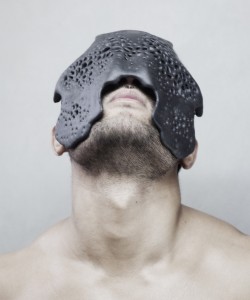MHOX Studios has been exploring 3D printing both as a means to create personalized, biocompatible medical devices and fashionable design accessories. Now, they are combining both experiences in their new CARAPACE PROJECT, which studies the mimicry of natural forms, such as exoskeletons of crustaceans, to produce wearable objects that are intended to be simultaneously visually and physiologically enhancing.

Carapace represents a vision of what the possible evolution of the human body might look like, with custom rigid elements, similar to the exoskeletons of crustaceans and insects, integrated to transform sense perception around the eyes, mouth or eras. The Carapace mask collection is inspired by this vision: they are fossils of a possible future, blurring the limit between a natural extension and an artificial prosthesis. Much like Mhox’s belt buckles, the Carapace pattern is biodigitally grown through a generative software simulation, which produces many different possibilities to choose from in order to set the correct structure, stiffness, and permeability.
Audiam is the Latin word for “I will hear” and the Audiam mask represents a possible exoskeletal evolution around the part of the head and brain where hearing occurs. The ears are connected, then, to the brain’s occipital lobe, seat of the sight sense, to better connect to the hearing sense, defining a new condition of “hyper-connectivity”. Vidiam, the Latin word meaning “I will see”, is a mask representing evolution in the visual area of the face. In this case the exoskeletal structure acts as a sort of defense against excessive external stimuli and the need for protection through identity’s concealment.
The collection of Carapace Masks is available into two different versions, Mater and Replica. Mater, the high end line, uses 3D scanning to customize the mask to the wearer’s face, and are produced as single pieces through CRP additive manufacturing capabilities and its Windform family of laser sintering materials. The Replica masks are standard fit and 3D printed in nylon with white and translucent material, meant to, in the studio’s words, “[recall] a fetal stadium in the individual’s growth”. If you thought Google Glass was a bit invasive, this might not be what you are looking for. Then again, Google Glass was intended to augment reality; these are intended to enhance the body and its senses. Perhaps this is what real wearable technology is going to look like.




